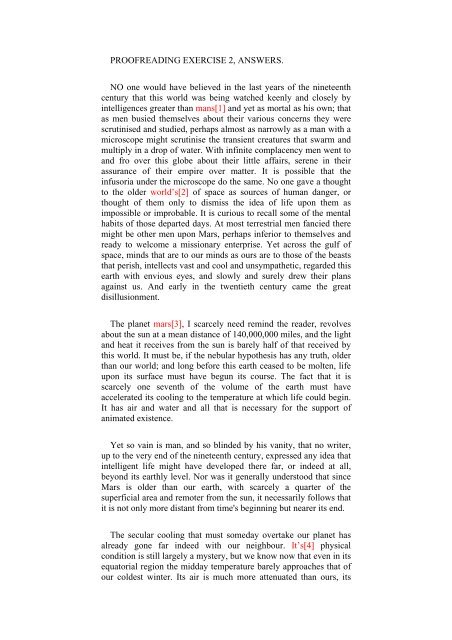Download File - The No-Nonsense Proofreading Course
Download File - The No-Nonsense Proofreading Course
Download File - The No-Nonsense Proofreading Course
You also want an ePaper? Increase the reach of your titles
YUMPU automatically turns print PDFs into web optimized ePapers that Google loves.
PROOFREADING EXERCISE 2, ANSWERS.<br />
NO one would have believed in the last years of the nineteenth<br />
century that this world was being watched keenly and closely by<br />
intelligences greater than mans[1] and yet as mortal as his own; that<br />
as men busied themselves about their various concerns they were<br />
scrutinised and studied, perhaps almost as narrowly as a man with a<br />
microscope might scrutinise the transient creatures that swarm and<br />
multiply in a drop of water. With infinite complacency men went to<br />
and fro over this globe about their little affairs, serene in their<br />
assurance of their empire over matter. It is possible that the<br />
infusoria under the microscope do the same. <strong>No</strong> one gave a thought<br />
to the older world’s[2] of space as sources of human danger, or<br />
thought of them only to dismiss the idea of life upon them as<br />
impossible or improbable. It is curious to recall some of the mental<br />
habits of those departed days. At most terrestrial men fancied there<br />
might be other men upon Mars, perhaps inferior to themselves and<br />
ready to welcome a missionary enterprise. Yet across the gulf of<br />
space, minds that are to our minds as ours are to those of the beasts<br />
that perish, intellects vast and cool and unsympathetic, regarded this<br />
earth with envious eyes, and slowly and surely drew their plans<br />
against us. And early in the twentieth century came the great<br />
disillusionment.<br />
<strong>The</strong> planet mars[3], I scarcely need remind the reader, revolves<br />
about the sun at a mean distance of 140,000,000 miles, and the light<br />
and heat it receives from the sun is barely half of that received by<br />
this world. It must be, if the nebular hypothesis has any truth, older<br />
than our world; and long before this earth ceased to be molten, life<br />
upon its surface must have begun its course. <strong>The</strong> fact that it is<br />
scarcely one seventh of the volume of the earth must have<br />
accelerated its cooling to the temperature at which life could begin.<br />
It has air and water and all that is necessary for the support of<br />
animated existence.<br />
Yet so vain is man, and so blinded by his vanity, that no writer,<br />
up to the very end of the nineteenth century, expressed any idea that<br />
intelligent life might have developed there far, or indeed at all,<br />
beyond its earthly level. <strong>No</strong>r was it generally understood that since<br />
Mars is older than our earth, with scarcely a quarter of the<br />
superficial area and remoter from the sun, it necessarily follows that<br />
it is not only more distant from time's beginning but nearer its end.<br />
<strong>The</strong> secular cooling that must someday overtake our planet has<br />
already gone far indeed with our neighbour. It’s[4] physical<br />
condition is still largely a mystery, but we know now that even in its<br />
equatorial region the midday temperature barely approaches that of<br />
our coldest winter. Its air is much more attenuated than ours, its




